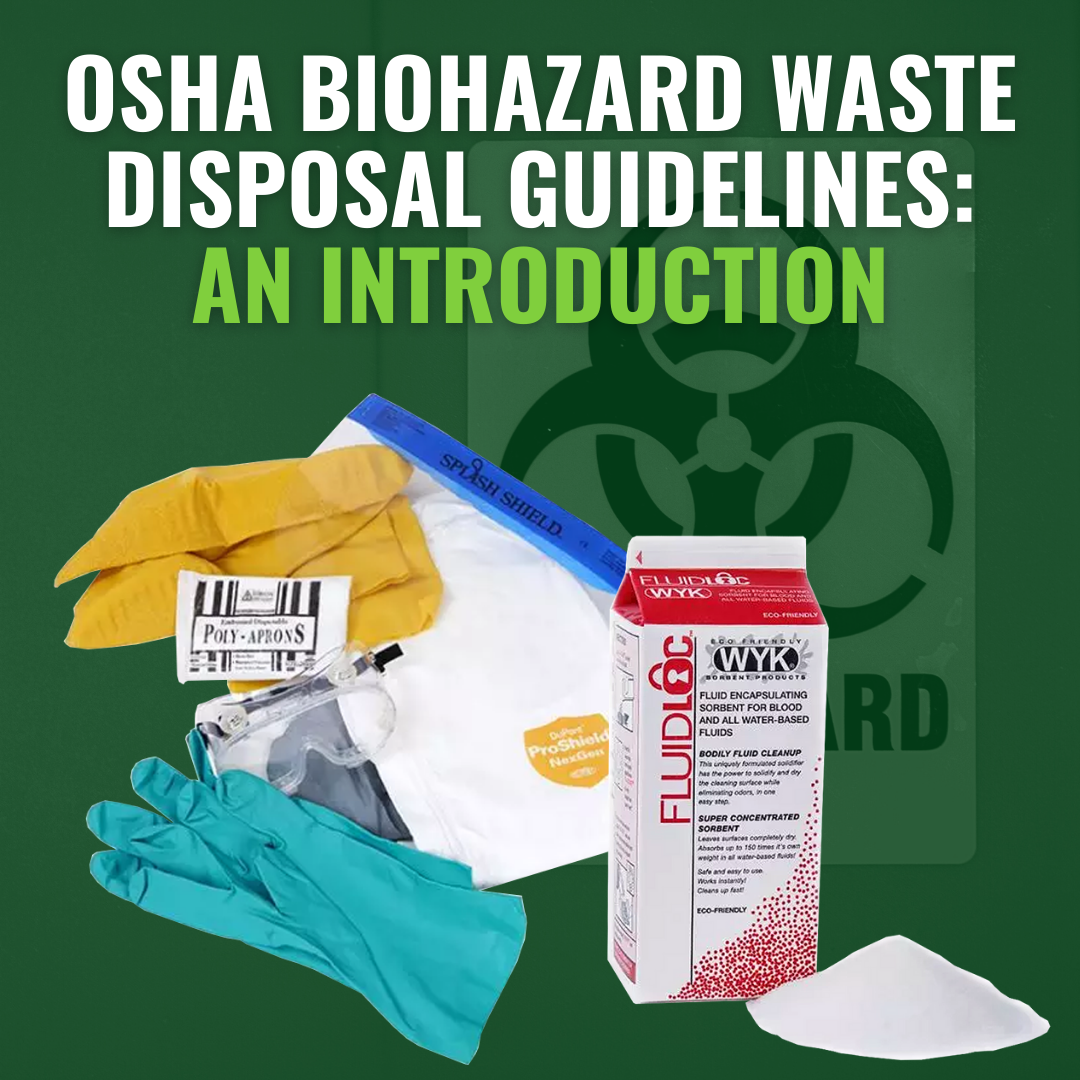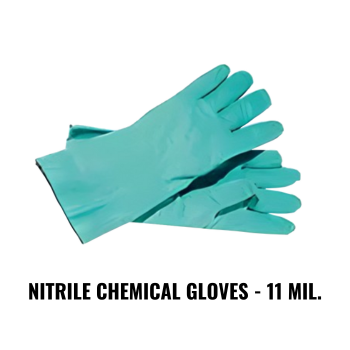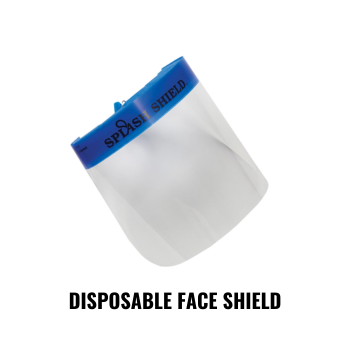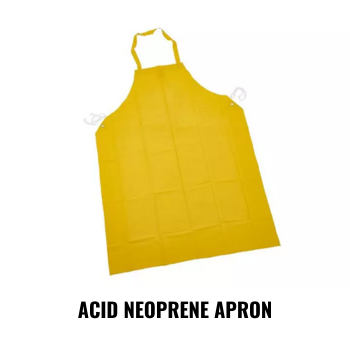We use cookies to make your experience better. To comply with the new e-Privacy directive, we need to ask for your consent to set the cookies. Learn more.
OSHA Biohazard Waste Disposal Guidelines: An Introduction
According to the Occupational Safety and Health Administration (OSHA), more than 5.5 million workers are at risk of exposure to bloodborne pathogens at work. While most of these workers are in the health care industry, workers in support roles — such as logistics, transportation, and specialized waste handling — share the hazard. In order to protect these workers, OSHA standards require employers to take certain steps to manage the hazard, including during risky waste handling tasks.

While this article is not intended as legal advice, here’s a brief introduction to OSHA biohazard waste disposal guidelines, based on publicly available OSHA standards. Before discussing these regulations, however, here are a few key definitions.
OSHA’s Definitions of “Biohazard” and “Bloodborne Pathogen”
OSHA defines biohazards as “infectious agents presenting a risk of death, injury, or illness to employees.” Compare that to OSHA’s definition of bloodborne pathogens, the subheading under which OSHA lists many of the rules that guide biohazard waste disposal. Bloodborne pathogens include “pathogenic microorganisms that are present in human blood and can cause disease in humans.” That includes viruses and other disease-carrying agents that cause illnesses from AIDS to hepatitis B and C.
So while bloodborne pathogens are biohazards, they’re not the only biohazards. Keep that in mind as we explore OSHA regulations related to biohazard waste; many of them are found in a section about bloodborne pathogens, but can also protect against other types of biohazards when applied appropriately. Note also that, while bloodborne pathogens have their source in blood, they’re also present in other bodily fluids and tissues, making OSHA’s bloodborne pathogen standards relevant when cleaning most types of body-related wastes.
OSHA Standards That Apply To Managing Biohazard Waste
The OSH Act of 1970’s General Duty Clause gives OSHA the power to address dangerous conditions at U.S. workplaces whether they’re addressed directly elsewhere in the standards or not. The clause requires employers to create “employment and a place of employment which are free from recognized hazards that are causing or are likely to cause death or serious physical harm” to employees. Pathogens spread by biohazardous wastes may indeed fall under this clause, and OSHA can cite workplaces that don’t provide suitable protections.
However, the OSHA standards also directly addresses the risks of biohazard waste in three dedicated standards:
- 1030 - Bloodborne Pathogens. This is the main legal source of OSHA biohazard waste disposal guidelines, providing lots of detail about best practices for avoiding on-the-job infections.
- 1910 Subpart I - Personal Protective Equipment Standards 1910.132 through 1910.140 discuss the personal protective equipment (PPE) employers must provide for their workers—including the PPE that protects against the pathogens associated with biohazards.
- 145 - Specifications for accident prevention signs and tags. This standard creates requirements for the labels and signs that mark a substance as a dangerous biohazard.
Applied specifically to waste-handling tasks, here are some of the key takeaways from all three of these standards.
1. Treat all blood, blood-contaminated items, and other potentially infectious materials (OPIM) as if they carry bloodborne pathogens.
According to OSHA standard 1910.1080(d)(1), compliant employers institute a policy of universal precautions when handling relevant biohazards. This means that “all human blood and certain human body fluids are treated as if known to be infectious for HIV, HBV, and other bloodborne pathogens.” In other words, when in doubt, assume that body fluids and materials that contain body fluids are infectious.
2. Create and maintain a written, regularly updated Exposure Control Plan for all employees exposed to blood and/or OPIM.
OSHA defines occupational exposure to biohazards as “reasonably anticipated skin, eye, mucous membrane, or parenteral contact with blood or other potentially infectious materials that may result from the performance of an employee’s duties.” This is likely to include all staff that handles biohazard waste. If your workers are subject to occupational exposure, you need to keep an Exposure Control Plan.
This plan must include:
- An exposure determination This section essentially determines which staff are at risk. It must include all the job classifications, tasks, and procedures in which occupational exposure may occur—without factoring in the use of personal protective equipment, or PPE (which employers must provide, though we’ll cover that later).
- Procedures and schedules for compliance. Exposure Control Plans should spell out the “methods of compliance” with standard 1910.1080, including engineering and work practice controls like hand-washing, PPE, proper storage containers, and labeling; microbiological practices for research laboratories; hepatitis B vaccination and exposure response; employee training and communication; and record-keeping.
- Procedures for studying and reporting on exposures. As part of the post-exposure evaluation and follow-up for exposure to hepatitis B, employers must document the circumstances surrounding the incident. The Exposure Control Plan should explain exactly how that report should be written.
Employers must provide written copies of Exposure Control Plans to employers. They must update Plans at least once a year, and consult frontline employees when planning the Plan’s protections.
3. Bloodborne biohazard wastes must be placed into special containers for handling and disposal.

According to standard 1910.1030(d)(2)(xiii)(A), not just any trash bag will do when handling biohazard waste. These containers must be built to prevent any leakage, and must have a dependably closable opening—which should remain closed during handling, storage, or transportation. These biohazard waste containers must be labeled and/or color-coded for immediate identification. Standard 1910.145(e)(4) requires a biohazard logo on signs for “equipment, containers, rooms, materials, experimental animals, or combinations thereof, which contain, or are contaminated with, viable hazardous agents.”
For obvious reasons, OSHA provides special rules for contaminated sharps—needles, blades, and other items that can puncture containers or skin. After use, workers should place these materials in labeled, leak-proof, and puncture-resistant containers for processing. For sharps and other biohazard wastes, if there’s a chance of leakage or outside contamination on the container, it must be placed in a second, secure outer container.
4. Provide appropriate personal protective equipment (PPE) for employees.

All employees who face occupational exposure to pathogens require appropriate PPE as a last line of defense against exposure, and that typically includes waste-handling staff. Employers must pay for the PPE, which may include, among other items:
The standards covering PPE for protection against bloodborne pathogens are found in standard number 1910.1030(d)(3). However, the PPE standards for general industry—1910 Subpart I—also apply for employers of cleaning staff. The disinfectants and chemicals used to clean biohazards can also damage skin, eyes, and mucous membranes. Consult Subpart I of the 1910 standards to ensure compliance with both sections of the OSHA regulations.

5. Worksites must remain clean, requiring frequent decontamination for surfaces and equipment and adequate spill response supplies.
Standard 1910.1030(2)(4)(I) requires employers to “ensure that the worksite is maintained in a clean and sanitary condition.” That means decontamination for all surfaces and equipment after every exposure, as well as after work shifts. But cleaning up blood and OPIM can be a challenge. A solidifying, fluid-trapping sorbent like FluidLoc helps to control spills, eliminate odors, and keep waste-handling staff safe. Sprinkle the product onto fluids to stop their spread and convert them to a sweepable solid. But helpful as it is, FluidLoc is not enough for OSHA compliance on its own. Employees also need hospital-grade disinfectants and appropriate PPE to handle spills. The FluidLoc Multi-Use Bloodborne Pathogen Spill & Clean Up Kit includes disinfectants, PPE, and a sealable, puncture-resistant container to help comply with OSHA biohazard waste guidelines.
6. Employers must provide ongoing training on safe working practices.

Training is a crucial first step for biohazard safety, and OSHA requires employers to provide that training during work hours and at no charge to staff. Standard 1910.1030(g)(2) lists details on these training programs, which must be repeated and/or updated at least annually. Employees can only perform workplace tasks after training and proof of proficiency in all safety protocols.
Biohazard Waste Disposal Rules Beyond OSHA
While OSHA’s standards focus on protecting employees, other agencies enforce rules to protect broader communities and the environment. At the federal level, the Environmental Protection Agency (EPA) regulates disposal of biohazards. (Learn more about EPA rules for health care waste here.) The U.S. Department of Transportation’s rules on packaging, labeling, and transporting biohazards are contained in the Code of Federal Regulations at 49 CFR, Parts 100-185, and administered by the DOT’s Pipeline and Hazardous Materials Safety Administration. The Centers for Disease Control and Prevention (CDC) provides further guidance on handling infectious materials, while the U.S. Department of Agriculture joins the CDC to oversee the Federal Select Agent Program, which regulates handling of biological agents, pathogens, and toxins.
Companies that dispose of biohazard wastes must also comply with all relevant state and local laws. In short, OSHA biohazard waste disposal guidelines are just one set of laws and regulations governing the handling of pathogens and other risky materials in the United States. Consult an attorney who specializes in biohazard waste handling for details on your specific operation. For more information about stainless steel Bin Dumpers with protective splash guards, call Solus Group at 314-696-0200.
